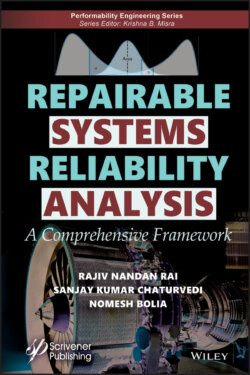Читать книгу Repairable Systems Reliability Analysis - Rajiv Nandan Rai - Страница 10
Оглавление
Series Editor Preface
This is the 10th book in the series on performability engineering since the series was launched in 2014. The subject of this book is special as not many books on Repairable System Reliability are available in the literature on reliability engineering. All the three authors of this book come from the reputed academic institutes of technology in India, but have also have had rich experience of working on field projects of practical importance. Incidentally, the two of the authors, namely, Rajiv Nandan Rai and Sanjay Kumar Chaturvedi are the postgraduate and doctorate, respectively, of the first Centre of Reliability Engineering established in India by the series Editor in 1983 at the Indian institute of Technology, at Kharagpur. Rajiv Nandan Rai has also served with the Indian Air Force and has had about 20 years of industrial experience in military aviation, which is reflected in the treatment of the subject.
Actually, the research in repairable systems reliability is limited and very few textbooks are available on the subject. The available textbooks generally provide coverage of non-homogeneous Poisson process (NHPP) where the repair effectiveness index (REI) is considered one. Few more textbooks provide treatment of non-parametric reliability analysis of repairable systems. However, this book aims to provide a comprehensive framework for the analysis of repairable systems considering both the non-parametric and parametric estimation of the failure data. The book also provides discussion of generalized renewal process (GRP) based arithmetic reduction of age (ARA) models along with its applications to repairable systems data from aviation industry.
Repair actions in military aviation may not fall under ‘as good as new (AGAN)’ and ‘as bad as old (ABAO)’ assumptions which often find limited uses in practical applications. But actual situation could lie somewhere between the two. A repairable system may end up in one of the five likely states subsequent to a repair: (i) as good as new, (ii) as bad as old, (iii) better than old but worse than new, (iv) better than new, and lastly, (v) worse than old. Existing probabilistic models used in repairable system analysis, such as the perfect renewal process (PRP) and the non-homogeneous Poisson process (NHPP), account for the first two states. In the concept of imperfect repair, the repair actions are unable to bring the system to as good as new state, but can transit to a stage that is somewhere between new and that of one preceding to a failure. Because of the requirement to have more precise analyses and predictions, the GRP can be of great interest to reduce the modelling ambiguity resulting from the above repair assumptions. The authors have discussed to a great extent various possibilities under repair-ability environment and applied them to physical systems. The book also summarizes the models and approaches available in the literature on the analysis of repairable system reliability.
It is expected the book will be very useful to all those who are designing or maintaining repairable systems.
Krishna B. Misra Series Editor
